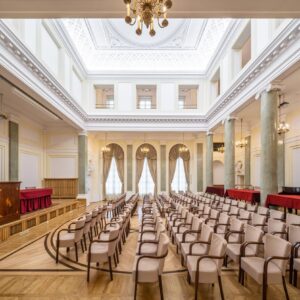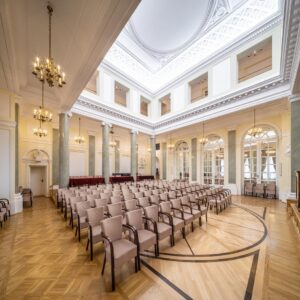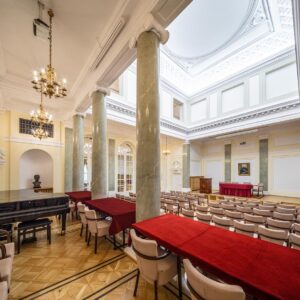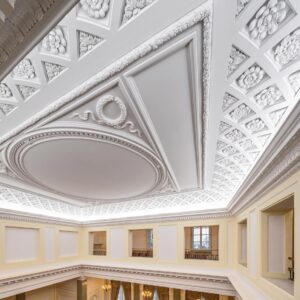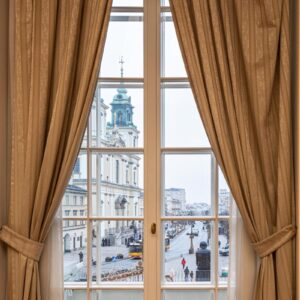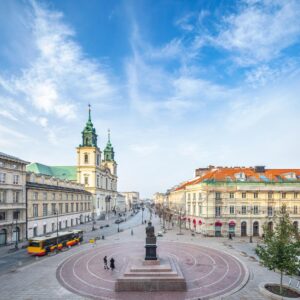- Wi-Fi
- Electric drop-down screen
- Flipchart
- Full HD Projector
- 380V connection
- Laptop
- Conference splitter (portable)
- Microphones, 4 pcs
- Local (interroom) transmission
- Online streaming
- the grand piano
- Number of seats – theater setting: 130 + 50 seats in the gallery on the second floor level
- Number of seats – table sides setting: none
- Number of seats – oval table setting: none
- Number of seats at the presiding table: 3
- Possibility to organize a secretariat in the lobby: yes
- Possibility to organize a buffet around the room: yes
- Possibility to arrange an exhibition space: none
- Possibility to organize concerts: yes
- View from the windows onto Krakowskie Przedmieście (perspective known from Canaletto’s paintings)
The Hall of Mirrors is found on the second floor in the central part of the building. It is the most representative conference room, accessible via the main internal staircase on the south-side axis of the historical part of the building. The post-WWII communication junction links the staircase directly with the Hall of Mirrors and may serve as a temporary foyer for a buffet event area and a location for a publisher’s stand or a conference secretary’s office. In this part of the building, the hall may be used as a buffet area. Paintings depicting collective portraits of scientific society members are a valuable element of the interior design of this building section. The unique touch is imparted by sculptures from the collection of Zofia Wolska.
Situated in the place of the historical, amphitheatrical meeting hall of the Warsaw Society of the Friends of Learning, the hall was conceived with large public events in mind. The hall may host not only conferences but also all kinds of celebrations, finals of competitions and subject Olympiads, anniversaries, presentations and music concerts. The room is furnished with modern multimedia equipment. The organizers of the events can also use the piano and sound system. The theater-arranged auditorium can accommodate 130 persons. Furthermore, the 50-seat gallery can be used as well. Both the Hall of Mirrors and a segment of the building adjacent thereto display the neoclassical style inspired by the design of the structure’s primary architect, Antoni Corazzi. As the Russians rebuilt the palace according to the project of Vladimir Pokrovsky, the meeting hall was adapted for an Orthodox church and replaced by a rectangular, spacious room with two rows of windows. In the process of palace reconstruction following the 1928 restoration of independence, Marian Lalewicz adopted a solution that placed the presidium with its back to the light. In the course of the 1940s palace restoration due to WWII damage, Piotr Biegański turned the hall axis parallel to the front façade and constructed a three-sided gallery on the second floor.
The work of the scientific institutions gathered today around the the Staszic Palace remains in continuity with the past generations of researchers. The Hall of Mirrors and the the Staszic Palace provide a space for bringing together not only representatives of a variety of institutions, environments, and generations, but also a place of science popularization, commemorations, and celebrations of important events.
Aleksandra Wójtowicz
